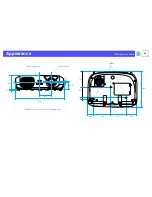
63
EMP-S1 User’s Guide
Appendices > Glossary
Refresh Rate
The light-emitting element of a display maintains the
same luminosity and colour for an extremely short
time. For this reason, the image must be scanned
many times per second in order to refresh the light-
emitting element. The number of refresh operations
per second is called the "refresh rate", and is
expressed in hertz (Hz).
Resized display
This function is used to project computer images that
have a resolution more than or less than the
projector's panel resolution, so that they fill the
whole of the projection area.
SDTV
An abbreviation for Standard Definition Television.
It refers to standard television systems which do not
satisfy the conditions for High-Definition Television.
Security
lock
A device consisting of a projector case with a hole in
it that a commercially-available theft-prevention
cable can be passed through in order to secure the
device to a table or pillar. This projector is
compatible with the Microsaver Security System
manufactured by Kensington.
Squeeze
mode
The method of compressing 16:9 Widescreen images
and recording them on video software as 4:3 images.
When projecting with Squeeze mode on, the images
will return to their original 16:9 format.
sRGB
An international standard for colour intervals that
was formulated so that colours which are reproduced
by video equipment can be handled easily by
computer operating systems (OS) and the Internet.
SVGA
A type of video signal with a resolution of 800
(horizontal)
×
600 (vertical) dots which is used by
IBM PC/AT-compatible computers.
S-Video
A type of video signal which has the video
brightness and colour signal information separated,
in order to provide better image quality. It refers to
images which consist of two independent signals:
Y(luminance signal), and C (colour signal).
Sync.
(Synchronisation)
The signals output from computers have a specific
frequency. Image quality will suffer if the projector
frequency and the computer frequency do not match.
The process of matching the phases of these signals
(the relative position of the crests and troughs in the
signal) is called "synchronisation". If the signals are
not synchronised, problems such as flickering,
blurriness and horizontal interference can occur.
Tracking
The signals output from computers have a specific
frequency. Image quality will suffer if the projector
frequency and the computer frequency do not match.
The process of matching the frequency of these
signals (the number of crests in the signal) is called
"tracking". If tracking is not carried out correctly,
wide vertical stripes will appear in the projected
images.
VGA
A type of video signal with a resolution of 640
(horizontal)
×
480 (vertical) dots which is used by
IBM PC/AT-compatible computers.
XGA
A type of video signal with a resolution of 1,024
(horizontal)
×
768 (vertical) dots which is used by
IBM PC/AT-compatible computers.










































